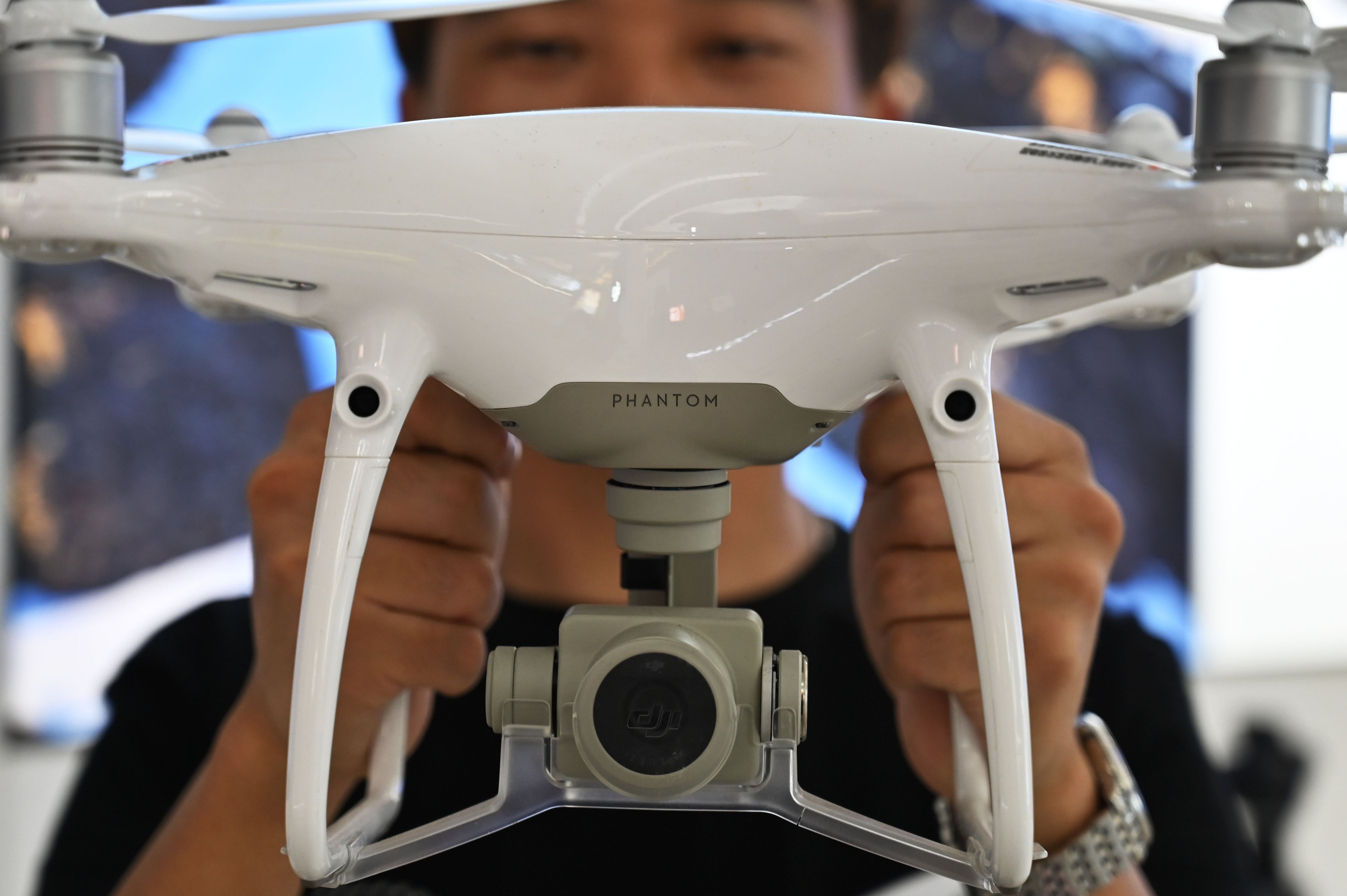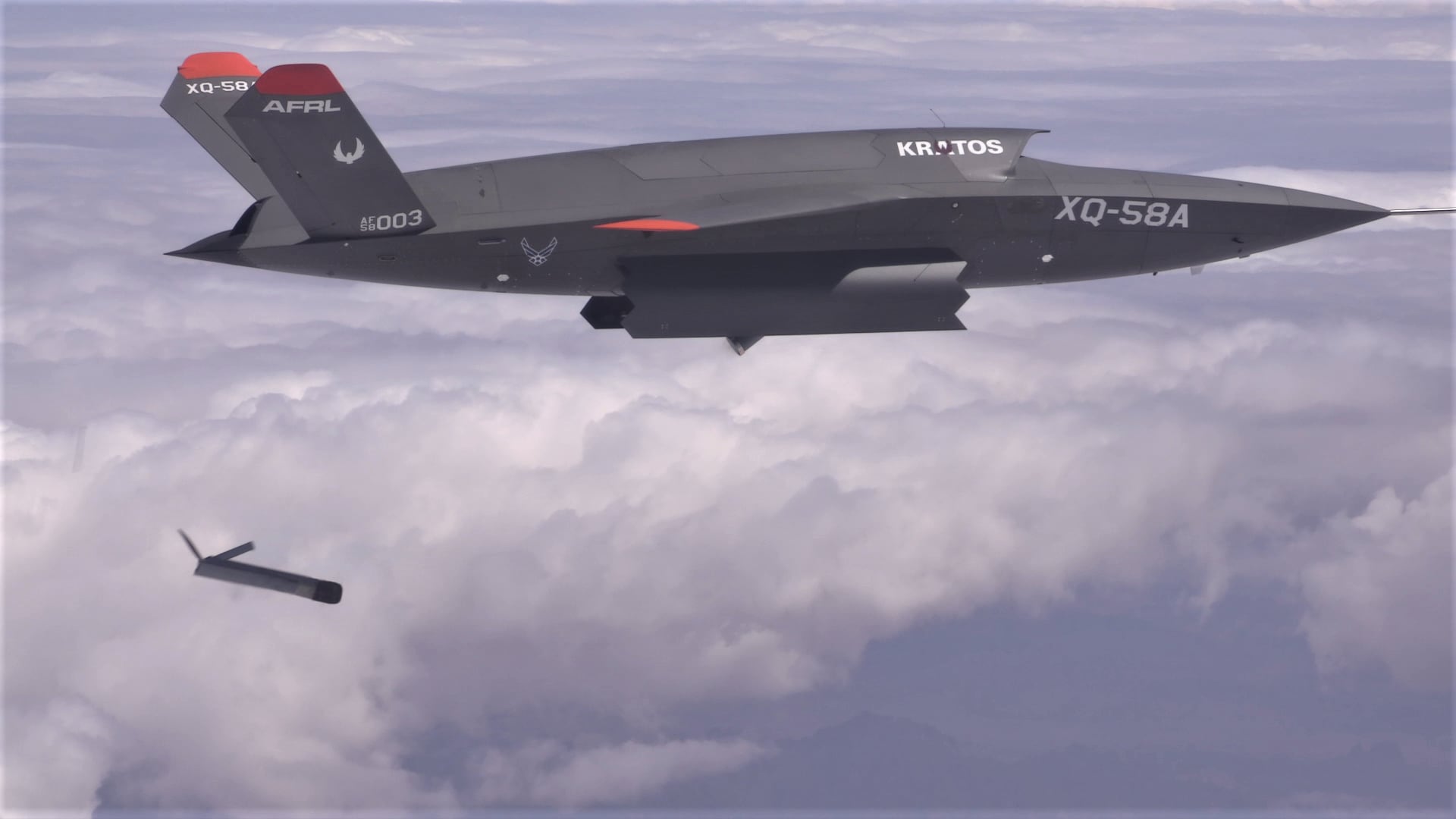
Victory in the next major conflict could very well depend on the effectiveness of drones — from their swarm capabilities to their surveillance and artificial intelligence technologies. In “Drone Wars: Pioneers, Killing Machines, Artificial Intelligence, and the Battle for the Future,” author and Defense News correspondent Seth J. Frantzman wonders: Who will be this victorious drone superpower?
The following excerpt was edited for length and clarity.
What if an enemy got a hold of this technology and used it against us? U.S. Marine Corps Commandant Robert Neller warned in April 2019 that drone swarms were heading our way.
Neller was sure that the future was not defending against enemy bombers, but “I think the real future in enemy air attack is going to be swarming drones.”
The Marines put a compact radar and electronic warfare device that looks like a giant pastry on top of jeeps. Called the Light Marine Air Defense Integrated System, or LMADIS, it can detect and kill drones. The Low Altitude Air Defense detachment of Marine Medium Tiltrotor Squadron 166 of the Thirteenth Marine Expeditionary Unit got to try it out. In July 2019, the Marines aboard the amphibious assault ship Boxer in the Arabian Gulf used the system to kill an Iranian drone.
The Air Force also built a satellite dish system called Tactical High Power Microwave Operational Responder, or THOR, at Kirtland Air Force Base near Albuquerque, New Mexico, that it tested in 2019. The unexotic system moves around in a storage container and uses a microwave burst to kill drones, like a flashlight blasting insects.
The rapid need to confront drone threats came in the wake not only of what the Iranians and the Islamic State group were doing but also an attack in Venezuela showing that a simple commercial drone could be armed with C4 explosives.
The technology to create drone swarms and confront them exists, but putting the anti-swarm technology at every base and location wasn’t possible. Even if counter-drone technology was deployed after laborious testing, the chance that a country or terrorist group using a drone swarm would also run into a base defended by the latest anti-drone technology to see how both work in actual combat is unlikely.
If the U.S. ever had to go to war with a major power such as China, then it could get to see if the swarms work against other advanced technology, but that is also a big gamble to take with the technology for the first time. This means all the prophecies about drone swarms changing the face of war are exciting, but they haven’t come to fruition. Iran’s attack on Saudi Arabia in September 2019 may have been a drone-swarm Pearl Harbor; but just as another 1941 Pearl Harbor never happened again, it may be that another Abqaiq won’t happen in the same way again. If it does happen, it will be faster, deadlier and more destructive.
A new world order
“UAVs are transforming current campaigns against extremists and enabling an entirely different way of pursuing combat operations in which we enable host-nation forces in a way that we never could in the past and help them defeat enemies like the Islamic State in their incarnation as an army, and then help host-nation forces pursue the remaining ISIS elements operating as insurgents and terrorists,” former CIA Director and retired Gen. David Petraeus told the author on March 14, 2020. He said that drones, “unmanned ships, tanks, subs, robots, computers and every additional conceivable system are also going to transform how we fight all campaigns. Over time, the man in the loop may be in developing the algorithm, not the operation of the unmanned system itself.”
The search for better drones came about the way it did in large part because the systems were successful in Iraq and Afghanistan. However, that led to lethargy and complacency in the world’s first drone superpower. There was no rapid need to develop new systems. Instead, there were experiments, and billions were spent on ideas. There was pushback from commanders who wanted traditional manned airplanes, like the F-35.
On the drone front, advances in technology were making drones more capable for everyone except the people with guns. Militaries were lagging behind in developing capabilities. Civilian drones led the way. China-based DJI had begun operations in 2006 and introduced the Phantom I in 2013. The Mavic was introduced in 2016 as a compact, portable drone. By then, DJI was on the way to gobbling up 72 percent of the global market for commercial drones, and by 2017 it had become a billion-dollar business.

DJI drones were used throughout the U.S. armed forces, along with some other smaller drones, such as Pumas and Switchblades, which were made by U.S.-based Aerovironment. But the Army was becoming more cyber-savvy. Lt. Gen. Joseph Anderson, deputy chief for plans and preparations, sent a letter in 2017 to commanders and soldiers telling them to cease and desist: “Uninstall all DJI applications, remove all batteries/storage media from devices, and secure equipment for follow on direction.”
The U.S. was right to be concerned about cybersecurity. In January 2018, users online noted that the Strava jogging app mistakenly revealed the courses special forces were running on secret bases in Syria, all because users’ jogging patterns were open to all.
Cheap, top secret and bizarre
Filling the gaps in the drone war was the name of the game after 2017. The U.S. and other countries now had a wide array of new products to test, and they were also trying to backfill in a bevy of vulnerabilities with new technology. For instance, General Atomics in San Diego, California, wanted to put a laser on its Avenger.
In March 2019, at Yuma Proving Grounds, Arizona, flying over the majestic high desert, another futuristic drone called the XQ-58A Valkyrie took flight. It was supposed to be able to penetrate enemy air defense. It was designed to be low cost and was pushed by the Air Force Research Laboratory at the Wright-Patterson Air Force base in Ohio.
The plane, which basically looks like the stealthy F-117 with its cockpit cut off, was built by Kratos, a company that was also making the drone swarm dubbed “Gremlins.” The XQ-58 would cost only several million dollars each. After so much spending, the Air Force was now looking to develop ideas that were affordable — perhaps drones that could be wingmen, or fly more autonomously and conduct missions themselves. The new shoestring budget was called low-cost, attritable aircraft technology.

Another futuristic idea was Skyborg, which was supposed to fly by 2023. It would be cheap and easy to replace, a kind of flying pod that could accompany aircraft. Acquisition director Will Roper said that Skyborg would take off, land by itself and fly in all weather conditions. These ideas were gaining traction because the new U.S. National Security Strategy envisioned more great power competition with states such as China, Russia or Iran. Now was the time to have more diverse options beyond the Predator and Global Hawk lines.
This was a positive shift, argued Paul Scharre, the vice president and director of studies at the Center for a New American Security. He hinted that the U.S. hadn’t built new platforms since 2009, noting that they relied on three combat aircraft: the F-35, the F-22 and the future B-21. “Diversity is really helpful to complicate things for the adversary.”
The real story was probably that the Air Force was reticent to plow money into new drones when its pilots wanted resources for their planes. Lt. Gen. Dave Deptula of the Mitchell Institute for Aerospace Studies said the Skyborg wouldn’t step on toes: “They have the potential for dramatically changing the game in the conduct of air operations.”
At the other extreme end of the drone world, the Defense Advanced Research Projects Agency’s Squad X idea was supposed to put tiny drones with artificial intelligence in the hands of soldiers. By 2020, the U.S. was drawing down soldiers in Afghanistan, its most successful field-testing ground for UAVs. The tiniest drones were called Black Hornets and could fly for 25 minutes. The Army hoped these insect-sized drones might one day become “standard.”
The Air Force also wanted more small UAVs. It already had fielded more than 150 Batcam drones for tactical air controllers, and it was looking at more micro-drones. The Batcam had the unusual luck of ending up in the Air Force museum. But America’s pilots still hadn’t settled on something that would be as widespread as Predator had been in the past. By 2019, the U.S. wanted to buy another 1,000 combat drones by 2030 and some 43,000 smaller or other surveillance drones.
The U.S. Army also used its other transaction authority — a loophole that lets it grab up new products to meet a need at up to $100 million a pop — to look at smaller drones that are man-packable, hoping to have something versatile to give to soldiers in the field. These drones can be carried in a backpack, making them ideal for small units or infantry at the front line. It wasn’t sure what the future would hold, wrapping up operations in Afghanistan and Iraq, but wanted a new range of drones for the next wars.
The Marines were also pushing for a capability for their ships, something called Marine Air-Ground Task Force Unmanned Aerial System Expeditionary, or MUX for short. This word salad of a name first looked like an X-wing from “Star Wars” and then a flying “V” with a prop in the front, and was supposed to be ready by 2026.

The fact that the Marines predicted this would take most of a decade to fly shows how sluggish U.S. planners were. They had been wanting these systems since 2015, when slide shows the Marines made called it “MQ-X.”
A study submitted to Congress had suggested tactical UAVs could move items to front-line troops, such as blood plasma or communications equipment. For the Army, more man-portable, platoon-level UAVs were supposed to be rolled out. In 2018, the Army decided it wanted to replace its fleet of tactical Shadow drones, seeking ideas for a “Future Tactical Unmanned Aircraft System (FTUAS).”
Martin UAV and Northrop Grumman came up with one idea — the V-Bat — while Textron Systems made something called the AAI Aerosonde, which looks like an Israeli twin-boom surveillance drone.
In fact, it showed not much had changed since the 1980s when it comes to how things look. Throughout 2020, various U.S. Army units, from Kentucky to Washington state and from Texas to North Carolina, would test and use the drones. They wanted something that didn’t need much of a runway and had better optics, made less sound, and didn’t need much extra stuff lying about to fly and control it. On the positive side, the zoo of new options showed everyone was finally getting access to drones.
The problem for the U.S. military was it didn’t really know what it wanted in the future. In an October 2019 meeting, Todd Harrison of the Center for Strategic and International Studies said that the U.S. should assess the possibility of using drones as a low-cost and highly available alternative to manned airplanes: “I think we need a road map for RPAs [remotely piloted aircraft] in terms of what are the new missions that we can begin to transition over to RPAs and some new operational concepts.”
Older aircraft, such as the Reaper, may have been jealous of these new concepts. If you’re an old dog, you need to learn new tricks: The Reaper took off and landed autonomously for the first time in October 2018.
This was the tip of the iceberg of U.S. problems. In dropping ideas like the futuristic X-47, or keeping them under wraps as classified programs, the Navy moved toward creating yet another experiment, a drone tanker MQ-25. It first flew in September 2019. Various countries’ air forces kept pushing a loyal wingman program, basically a drone mule that would help manned aircraft.
In early May 2020, Boeing finally got the go-ahead from the Royal Australian Air Force to introduce the Airpower Teaming System, which it had unveiled in 2019. The plane is sleek and looks like a normal fighter plane if you chopped the top off and kept the wings and half the fuselage. It is paired with fighter aircraft to help carry out some duties.
Another problem was trying to plan for the future war by uploading the correct data to the drones once they were flying in a crowded airspace. The future war would have an airspace that would be crowded like a highway with helicopter drones, like the futuristic Bell V-247, swarms of mini-drones, kamikaze drones fired from tubes on ships, tactical catapult-launched drones by Marines landing on a beach, and drones flown by special ops soldiers on a hill nearby.
All that would be watched by a stealthy flying wing and a combat air patrol of other drones armed with Hellfire missiles. Eventually, they would run into each other. So another acronym had to be invented: Air Space Total Awareness for Rapid Tactical Execution.
In 2020, DARPA went looking for a network that could coordinate everything. The Israelis already had it in something called a “glass battlefield” being built for the Germans, which would network all units together on the battlefield. This was part of Rafael Advanced Defense Systems’ BNET communications system and Fire Weaver that was supposed to digitize units at the front line so they wouldn’t have to rely on cumbersome mountains of radios and different systems to talk to different units.
For more, visit the publisher’s page at https://posthillpress.com/book/drone-wars-pioneers-killing-machines-artificial-intelligence-and-the-battle-for-the-future.
Seth J. Frantzman is the Israel correspondent for Defense News. He has covered conflict in the Mideast since 2010 for different publications. He has experience covering the international coalition against the Islamic State group in Iraq and Syria, and he is a co-founder and executive director of the Middle East Center for Reporting and Analysis.





